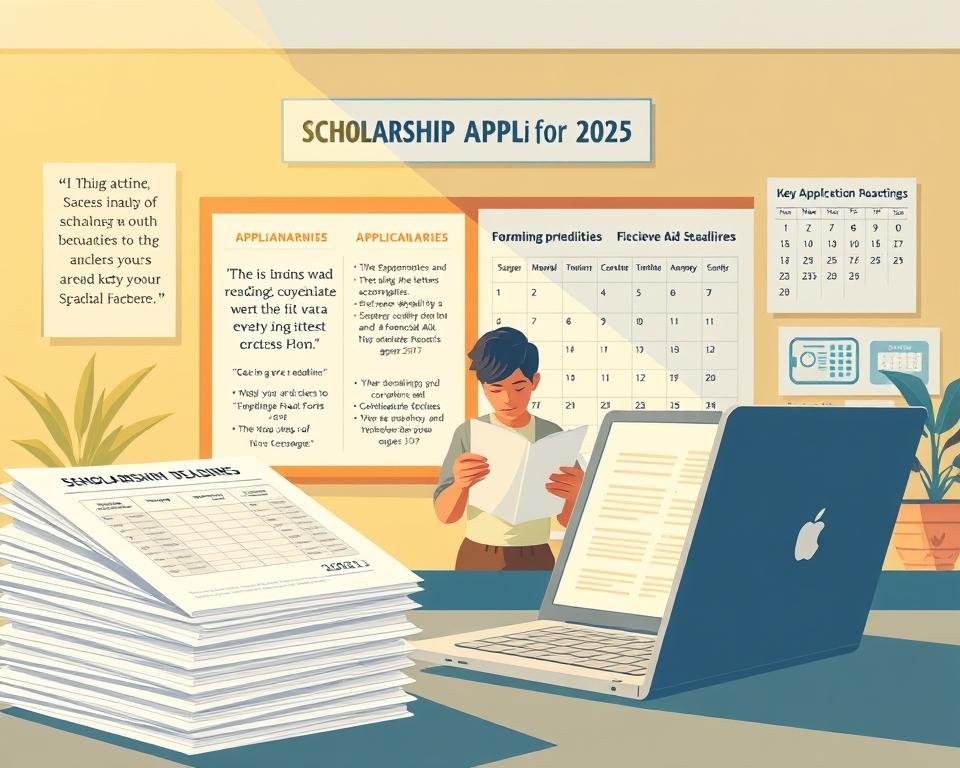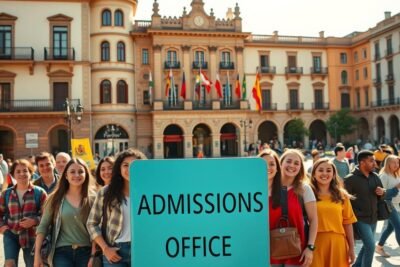
Complete Guide to Applying for Scholarships, Jobs, and Visas 2025

Starting your journey to education and growth is exciting yet uncertain. Whether you're looking to apply for scholarships or get a visa, you need the right tools. This guide will help you understand how to apply for scholarships and find financial aid for college in 2025.
Start Your Application by Country
We'll explore scholarship opportunities that fit your needs. Let's start this journey together. We'll make sure you're ready to reach your dreams.
Start Your Application by Country
When you think about applying for programs abroad, it's key to plan based on where you want to go. The United States is a top pick for many international students looking for a degree. Knowing about scholarships for international students in the U.S. can really help with your education costs.

How to Apply for MBA Programs in Australia 2025

Secure Internships Abroad: Apply with Success

Applying to US Universities: Guide for Internationals

Requirements for Undergraduate Admission in the US

Ace Your US University Application: Essential Preparation Guide
There are many scholarships out there, from those based on merit to those based on need. Programs like the Fulbright Program and scholarships from universities can offer a lot of financial help. It's smart to look for scholarships that match your field of study to increase your chances.
Getting a student visa is also a big part of the application process. The F-1 visa lets international students study in the U.S. and has certain rules. Students need to get into a school that's approved and show they can pay for their education and living costs.
To do well in this process, you should look into each university's needs and what scholarships they offer. For more info on scholarships for international students, check out this useful guide.

In short, starting your application for U.S. schools means understanding the scholarships out there, making sure you meet visa rules, and following what each school requires. This careful planning will help you find the best opportunities for your academic path.
Applying for Scholarships
Knowing about different scholarships can really help you get financial aid for school. Scholarships fall into two main groups: need-based and merit-based. It's important to understand these to find the right scholarships for you. You need to check if you meet the scholarship's requirements, like your grades, financial situation, and where you live.
Understanding Different Types of Scholarships

Applying for International Student Scholarships UK

UK University Application Guide for Internationals

How to Apply Online to Universities in the UK

UK Skilled Worker Visa: Your Step-by-Step Guide 2025
There are scholarships for different needs and students. Need-based scholarships help those who are financially struggling. Merit-based scholarships go to students who excel academically or have special talents. Scholarships for specific programs or schools are also available. Knowing about these can help you find the right scholarship for you.
Eligibility Requirements for Scholarships
Each scholarship has its own rules for who can apply. Some common things they look at include:
- How well you do in school, like your GPA or test scores.
- If you really need the money, for need-based scholarships.
- Where you live, which can affect if you can get a scholarship.
- Special skills or knowledge needed for certain programs.
Every scholarship is different, so make sure to read the rules carefully. This will help you have a better chance of getting the scholarship you want.

Scholarship Application Tips for 2025
Getting a scholarship requires careful planning, creativity, and being true to yourself. These scholarship application tips guide you through the process. They help you find the right opportunities that match your goals and background.
Researching Scholarship Opportunities
It's important to look for different scholarships. Use trusted sources to find ones that fit your study field, culture, or special talents. Many websites have filters to help you find scholarships by country, study level, or type. This makes it easier to find the right ones for you.
Crafting a Compelling Scholarship Essay
Writing a good scholarship essay can make you stand out. It should tell your story, show your goals, and explain why you need the scholarship. Share your experiences and be honest to connect with the selection committee.
Gathering Strong Letters of Recommendation
Getting strong recommendation letters boosts your application. Ask people like teachers, bosses, or community leaders who know you well. Give them details about the scholarship and what makes you a good candidate for it.

How to Apply for MBA Programs in Canada 2025

International Students: Your Guide to Applying to Canadian Universities

Requirements for undergraduate admission for Students in Canada

Financial Aid for College: An Overview
It's key to know the different financial aid options for college students. This includes scholarships, grants, and loans. Understanding need-based vs merit-based scholarships is important. Knowing these helps students plan their college finances better.
Need-Based vs. Merit-Based Scholarships
Need-based scholarships help students who can't afford college on their own. Merit-based scholarships go to students who excel academically or have special talents. Both kinds help make college more affordable. Knowing the difference helps students find the right aid for them.
Understanding the FAFSA Process
Filling out the Free Application for Federal Student Aid (FAFSA) is a big step for U.S. students. It's a key to getting federal and state financial aid. Students need to know the eligibility rules to get the aid they need.
For example, scholarships are not evenly distributed. White students get 70% of full-tuition scholarships. Hispanic students get 9%, and Black students get just 6%. This shows why it's important to understand all aid options. Check out this article for more on financial aid disparities.
How to Search for Scholarships Effectively



Looking for scholarships can feel overwhelming. But, using the right strategies can make it easier. Start by checking online databases that list scholarships for students in the U.S. Sites like Fastweb and Cappex have lots of options. They let you create profiles to find scholarships that match your skills and interests.
Don't forget to use your college's resources. The financial aid office often knows about scholarships from alumni or departments. These can be great opportunities that aren't well-known.
Local groups, non-profits, and professional associations also offer scholarships. Getting involved in these communities can help you find special funding. When searching, use specific details like your field of study or financial situation to find better matches.
Spending time to customize your scholarship applications can really pay off. By using these strategies, you can increase your chances of getting the funding you need. This will help you reach your educational goals.
Write Winning Scholarship Essays
Writing a great scholarship essay is key to standing out. A clear and engaging essay structure is vital. It helps share your personal story effectively. Focus on your unique experiences that match the scholarship's goals.










This approach not only shows you're qualified but also makes you a top contender.
Structuring Your Essay for Maximum Impact
A good essay has a strong intro, detailed body paragraphs, and a clear conclusion. The intro should catch the reader's eye, giving a sneak peek into your main point. Each body paragraph should dive deeper into your experiences, showing how they connect to your goals and character.
A solid conclusion ties everything back to your main theme. It reiterates your dedication and vision.
To improve your essay structure, make sure each paragraph flows well. This keeps the reader interested and helps your story make sense. Looking at successful essays can offer valuable tips.
Common Mistakes to Avoid in Your Essay
When writing essays, watch out for common mistakes. Avoid generalizing your experiences. Specific, detailed examples make a stronger impression, showing your unique qualities and passion.
Following the guidelines closely is also critical. Ignoring them can hurt your application a lot.
Don't overlook proofreading. Mistakes in spelling or grammar can hurt your essay's professionalism. Get feedback from a friend or mentor before you submit.
For more tips on scholarship applications, check out important scholarship opportunities.
Job Application Tips for International Students
For international students, finding a job can be tough but also rewarding. It's key to know how to write a good resume and prepare for interviews. Showing your unique skills and tailoring your application can make you stand out.

How to Apply to Universities in Australia as an International Student

Common mistakes when applyfor students ing to Australia programs

Guide to prepare a strong application for Australia universities
Crafting an Effective Resume and Cover Letter
Start with a clear and relevant resume. Use simple language and focus on your achievements and skills. Make sure your resume has sections for education, work experience, and skills.
A cover letter is your chance to introduce yourself. Explain why you're the best fit for the job. Mention specific experiences that match the job description.
Preparing for Job Interviews
Getting ready for interviews is vital. Learn about the company and its culture. This will help you answer questions better.
Practice answering common interview questions. This will help you speak clearly and confidently. Mock interviews can also boost your confidence.
When you talk about your experiences in the interview, show you're really interested. This shows you're committed to the job.
Student Visas: What You Need to Know
When you want to study abroad, knowing about student visa requirements is key. It's important to learn about the different student visas available in various countries. Each country has its own rules for who can get a visa and how to apply.
Types of Student Visas by Country
Every country has its own student visa types, based on what kind of education you're looking for. In the United States, for example, there are F-1 visas for college, M-1 visas for vocational training, and J-1 visas for exchange programs. Each visa has its own requirements and conditions.
Eligibility Requirements and Application Process
To get a student visa, you need more than just an acceptance letter. You must also show you have enough money for school and living costs. Your passport must be valid, and you might need health insurance. In the U.S., start preparing for your visa application at least three months before school starts. For tips on avoiding mistakes, check out this helpful guide.
Understanding how to apply for student visas can make your journey easier. With the right help and planning, you can increase your chances of getting a visa.
Full Degree Applications: Step-by-Step Guide
Starting full degree applications can be challenging but fulfilling. A detailed step-by-step application guide makes this journey smoother. First, research the specific needs for applying for colleges abroad. Each school has its own rules, so your application must fit perfectly.
Next, collect all required documents like transcripts and test scores. Your personal statement is key to sharing your goals and dreams. Write these carefully, as they greatly affect your admission chances.
Managing your application schedule is vital. Keep track of deadlines to avoid delays. If interviews or auditions are needed, prepare well to stand out.
If you're looking to enhance your application, consider scholarships. The University of Edinburgh offers such opportunities. You can find details in this scholarship guide.
In conclusion, a methodical approach to full degree applications boosts your success rate. Emphasize personalization and thorough preparation at every stage. This shows your dedication to higher education and strengthens your application.
How to Avoid Common Application Mistakes
Many people struggle with application mistakes. These mistakes can hurt their chances of getting scholarships, jobs, or visas. Common errors include not following instructions, missing deadlines, or submitting incomplete forms. Knowing these pitfalls is key to improving your chances.
One good way to avoid these mistakes is to pay close attention to details. Read all application guidelines carefully and make a checklist. This helps you make sure you don't miss anything, reducing the chance of errors.
Getting feedback from mentors or advisors is also very helpful. By sharing your drafts with them, you can get valuable feedback. This feedback can help you make your application better, making it more likely to succeed.
Here are some tips for successful applications:
- Start early to have enough time to prepare.
- Double-check all your information for accuracy.
- Write clearly and simply, avoiding complicated language.
- Make sure you have all the necessary documents before you submit.
| Error Type | Consequences | How to Avoid |
|---|---|---|
| Not following instructions | Application may be disqualified | Read guidelines thoroughly |
| Missing deadlines | Ineligibility for consideration | Set reminders for important dates |
| Submitting incomplete applications | Reduced chances of success | Create a checklist and review it |
| Poor presentation | Unprofessional appearance | Seek feedback and revise carefully |
Ready to Submit Your Application?
As you near the end of your scholarship application, it's key to do final checks. Make sure you have all needed documents, like academic transcripts and proof of English skills. Your personal statement should stand out, showing your best qualities.
Look over your essay drafts for clarity and flow. A strong essay can set you apart. It should show your achievements and goals clearly. If unsure, ask for feedback from teachers or friends.
Also, check that your application meets all the program's needs. Each program has its own rules. Paying close attention to these can boost your chances. For more help, check out this resource.
Frequently Asked Questions (FAQs)
- What documents do I need to apply for a student visa?
Most student visa applications require a passport, proof of admission, financial support, and language test results. - Can I apply for scholarships and jobs at the same time?
Yes, and it's recommended to do so early in the process to maximize opportunities. - Is there a universal platform to apply to all countries?
No. Each country has its own application portals, but our guides help simplify each one step-by-step. - How do I avoid getting my application rejected?
By following requirements carefully, meeting deadlines, and submitting a complete, accurate application.
